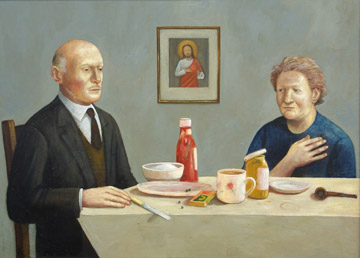
| HOME |
| NERVE |
| REVIEWS |
| ARCHIVE |
| EVENTS |
| LINKS |
| ABOUT US |
| CONTRIBUTORS |
| BACK ISSUES |
| CONTACT US |
 The Living
and the Dead
The Living
and the Dead
John Kirby retrospective
Walker Art Gallery
13th January 2012 – 15th April 2012
Reviewed by Sandra Gibson
Not wishing to cause his staunch catholic family any embarrassment, John Kirby (born 1949) left Liverpool for a life in London that left him free to be himself. His paintings create an overwhelming sense of solemn alienation, and sexual disorientation. These are depictions of people locked inside themselves, posing in role as if to have a photograph taken - reminiscent of some of Hopper’s paintings. Often created with a dark background, the pictures are not social narratives so much as existential explorations; not domestic so much as ritual. A woman is caught the moment before she washes her hands; the scene is imbued with theatrical (religious?) significance. A man in funereal suit and tie is caught the moment before he eats The Last Supper (above). Not even the humdrum sauce bottle can diminish the solemnity of the occasion.
In a short film John Kirby talks about a dream he had in which he had murdered someone and buried the body beneath the floorboards. In order to contain the stench he nailed the boards more and more securely. Two things are obvious from this easily interpreted dream: the absurd inadequacy of this act of denial and the sense of appalled shame.
A naked man in a crown and veil prays over a dead rat and you can’t resist the mischievous thought: has anyone smelt it yet? The sense of ritual is supported by the appearance of catholic emblems and this, together with the absence of a social environment, creates a surrealist element. In one painting two choristers are fighting outdoors whilst a third figure approaches from very far away – we are on the humorously grotesque edge of Father Ted territory: what new element of chaos will Father Jack bring? Or is it Mrs Doyle to quell the savagery with tea on a tray?
Sexual and cultural disquiet is combined in the painting of the black child just off the boat from Jamaica, juxtaposed with a white, flaxen haired, female doll. White Wedding has an element of humour: two black men in white suits are portrayed on the occasion of their civil partnership ceremony. But your smile soon dissolves when you see the expression in their eyes. They confront you with their trapped fear and the sense that they have seen too much. And these unwavering gazes are repeated time and again, time and again; in child and in adult, the look is the same.
There is also a strand of transvestism in Kirby’s paintings but the artist has expunged the Lily Savage factor: the theatrical drag-glamour which masks identity, to show the steady and - I would suggest - courageous gaze of pain. There is something touchingly innocent about the short-haired male figure with a naked torso wearing a skirt such as a young girl might wear. A similar self portrait shows the painter in grey off-the-shoulder garment decorated with a red flower. This painting has some eroticism, as has the enigmatic sculpture of a head in a meshed basket which evokes the fetishism of that inadequate concealment, the veil, together with the ghoulish idea of decapitation.
And this, perhaps, is the key image: sexuality, and omnipresent censure when someone smells the exposed rat. Yet the artist has managed to express compassion for the human condition; hopefully for himself, too.
PS Pop trivia: Virgin of Sorrows, the largest painting in the exhibition, shows a naked figure (appropriately asexual – it could be a pre-pubescent male or female) in a white confirmation veil. It was previously owned by Madonna!